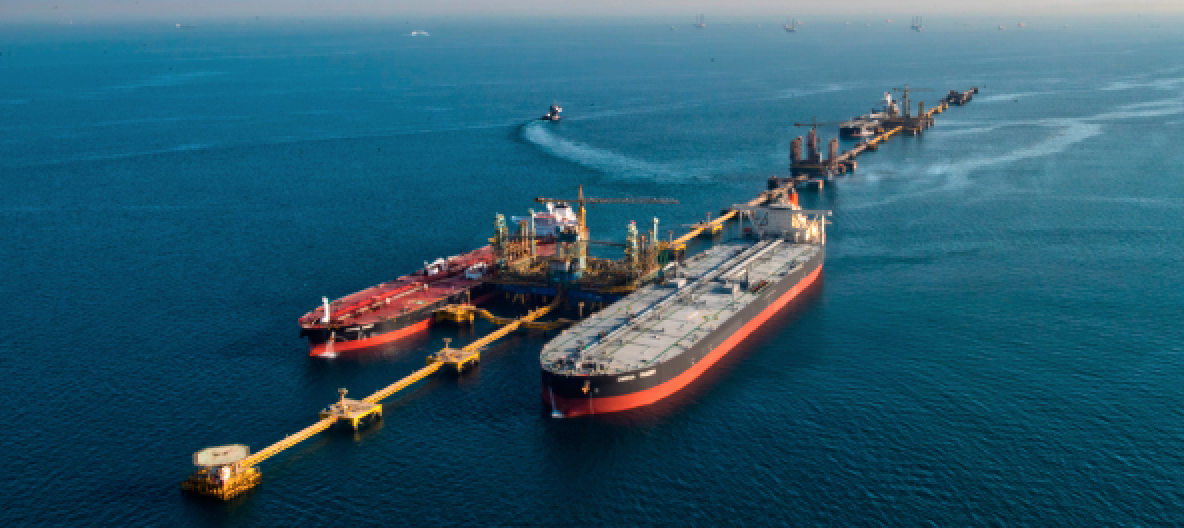I remember that when I joined Saudi Aramco, one of the largest Oil and Gas (O&G) companies in the world, in the early of 1980s, HF radio systems were used to provide radio voice connectivity between the onshore/offshore remote operations and their control canters.
 The Shaybah field is located at the northern edge of the Ar Rub’ al Khali (known as the “Empty Quarter”) desert in Saudi Arabia. Photo is courtesy of Aramco.
The Shaybah field is located at the northern edge of the Ar Rub’ al Khali (known as the “Empty Quarter”) desert in Saudi Arabia. Photo is courtesy of Aramco.
Then VHF arrived and extended subscribers system and was introduced to provide voice telephone services that used to require excessive and expensive field trips and visits to realign the antennas once the drilling rig moves to another new drilling location.
In the early 1990s, as the demand for reliable and higher data speeds were needed, Inmarsat ’s satellite communications (SATCOM) system was introduced to provide voice and limited data connectivity of 9.6 kb/s and then 64kb/s. Following this, in the early 2000, Very Small Aperture Terminal (VSAT) services based on GEO satellites were introduced to provide 2 mb/s data connectivity and is still fully involved in operations today.
GEO satellites still dominate the SATCOM world and have been in operations for almost 50 years and they continue to provide multiple onshore/offshore daily communication connectivity and services, such as wideband/narrowband VSAT, TV, mobile, aircraft as well as backhaul systems and services.
Nowadays, the demand for much higher data speeds for O&G operations is growing to meet the digitization transformations and GEO satellite systems are barely meeting this ever increasing demand. Hence, Low Earth Orbit (LEO) satellite systems might be an optimal solution to meet and satisfy this demand.
LEO satellite systems are certainly not new to the market. The introduction of LEO concepts brings to mind the 1990s, when several companies tried to provide global connectivity via LEO such as Globalstar, Iridium, Odyssey, and Teledesic. In the end, however, all but Iridium scaled back or cancelled their intended constellations due to high costs and limited demand — all suffered financial problems.

Shaybah pipeline, photo courtesy of Aramco
After that experience, many industry analysts and investors remained sceptical as to the viability of large LEO constellations. Teledesc, for example, was established to deliver internet service over satellite through 840 LEO constellations. However, due to the expensive satellite manufacturing and launch costs at that time, as well as expensive end user devices and a limited number of users, the Teledesic system and that company’s plan failed.
These days, with advanced technology to manufacture satellite systems, the low cost of satellites and end user devices, as well as the rising demand for higher download internet services, could the Teledesic system be a successful LEO constellation system today?
GEO vs. LEO
GEO satellites are situated above the Earth at a very high altitude of about 36,000 km (22,200 miles) above the equator. They rotate around the Earth as a about every 23 hours, 56 minutes and 4 seconds.
The Earth rotates around its equator every 24 hours and there there is no Earth gravity impact at GEO altitude. Therefore, the GEO satellites appear fixed to any position or location in the ground as both rotate at the same velocity speed, hence the name GEO, (Geostationary Earth Orbit).

The Shaybah field, photo courtesy of Aramco
Due to the high altitude of GEO satellites, the time delay or latency of these satellites is about 650 ms which impacts real time interactive voice and video traffics well as playing interactive games on the internet. However, for other services such as TV broadcasting, this high latency is not an issue. All TV broadcasting and VSAT services are currently in operation via GEO satellite systems and will continue to do so for some time to come.
Placed at high altitude, three GEO satellite are enough to cover the entire world and three control, ground stations are required to control the GEO satellites. The data speed over GEO satellites is still limited due to many aspect factors that include the expensive and large size of end user equipment, as well as the various types of modulations and codings as well ashigh latency and propagations.
On the other hand, LEO satellites are located and operated at much lower distances above the Earth. They are located at altitudes around 1,200 km (750 miles) as compared to 36,000 km (22,200 miles) of the GEO The LEO constellations have a much lower latency, 36,000 km (22,200 miles) of the GEO The LEO constellations have a much lower late in the neighborhood of 25 to 35 ms, as compared to about 650 ms for GEO satellites.
Moreover, LEO satellites will use various techniques, such as spot beams and frequency reuse, to significantly increase capacity and deliver higher bandwidth rates to users. Due to the pull of Earth gravity, as they are located at a low altitude, LEO satellites move at extremely high speeds. They rotate around the Earth every 90 minutes and, as a result, each constellation requires hundreds of satellites, covering the entire globe, to provide continuous connectivity for any given area.
The low latency of LEOs compared to GEO satellites is a key factor and considered an advantage to deliver real time communications and they play a major role in applications that require real-time, data control and monitoring, such as voice over internet protocol that require real-time, data control and monitoring, such as voice over internet pro (VoIP), surveillance and imaging, telemedicine, and remote-controlled machines.

Hasbah Field rigs, photo courtesy of Aramco
LEO Systems + Companies
With satellites becoming easier and less expensive to build and launch, many private companies now have the oppor tunity to join the space market segments and provide high- demand ser vices for individuals, businesses, research institutes and government organizations.
There are a number of satellite systems and companies that have been founded to provide communication services through LEO constellations. Some of these companies include SpaceX’s Starlink, OneWeb, LEOSat, OQ and Telesat.
These companies have been working to develop and manufacture a constellation of LEO satellites that are designed to offer high speed and low latency, broadband services to underserved regions of the world.
Starlink is one of the most well-known, LEO broadband providers and that constellation is planning to launch 4,400 satellites. Typical speeds offered by Starlink range between 20 to 100 mbps download and between 5 to 15 mbps upload. SpaceX says it will be able to provide broadband service up to 1 Gbps for the end user.
OneWeb is planning to manufacture and launch about 684 LEO satellites. Telesat, with a proposed initial constellation of 117 spacecraft, is planning to deploy more than 500. Amazon is also an up-and-coming competitor with their Project Kuiper and a planned 3,236-satellite constellation in LEO.
Due to the failure of the first LEO systems introduced in the 90s, a question for today is... will these new LEO companies succeed? Before this question is answered, it is worth mentioning that dramatic improvements have occurred in communication technology since the 1990s and there are two main factors considered in the satellite industry.
Those revolved around the cost to manufacture and launch the satellites to their orbits. Nowadays, satellites are smaller, lighter and a less expensive means of launching many satellites simultaneously, allowing many more LEO companies to succeed with their plans.
There have also been changes in end user devices. At the time of Teledesic, for example, most tracking antennas were parabolic, which means mechanical antennas rotating on various axis in order to remain pointed at the satellite. If more than one satellite had to be tracked, there had to be more than one antenna.

Khurais Oil Plant, photo courtesy of Aramco
New flat panel antenna (FPA) technology will track multiple satellites at the same time, using a laptop cover sized antenna that may be mounted on fixed and moving platforms such as homes, businesses, busses, trains, planes and boats.
Massive production of these end user devices will bring their prices down, as well. Moreover, these antenna will be easy to install, unlike traditional VSAT parabolic antennas that have to be carefully aligned and pointed to the satellite.
Another promising successful factor for LEO is the high demand for high speed internet. In the 90’s, the internet has just started — today, people are trained in the use of smartphones and laptops and everyone is connected to the internet for everything from business, to entertainment, to socializing, to IoT (Internet of Things) where everything is connected to the internet.
Moreover, planning to sell the internet service directly to the end user instead of through service providers will strengthen the successful of LEO satellite operations and services. OneWeb and SpaceX already sell their services directly to end customers. Most customers will be able to easily install their own devices and will be able to select online service plans that are similar to the GSM (Global System for Mobile Communications) services.
For years, VSAT terminals were essentially the only way to reliably transmit and receive data O&G operations — mainly for the drilling rigs and seismic explorations. However, there are hundreds of thousands of assets, as well as millions of kilometers of pipelines across the globe, that are being monitored and operated manually through expensive site
visits due to the large size, high cost and energy consumption of VSAT terminals which make it impossible to connect every desired location.

Ras Tanura Sea Island is part of the Ras Tanura Port’s infrastructure and provides additional berths for tankers to load. Photo courtesy of Aramco
With the cost reduction of using LEO end user devices and LEO satellite bandwidth connectivity, these assets now have the potential to be operated and monitored remotely and that will reduce operation costs, minimize field visits, reduce downtimes and improve predictive maintenance. Also, connecting these remote assets to their control centers will increase the safety measures of both assets and personnel.
Conclusion
GEO and LEO satellites provide identical services across the world: voice, video and internet. LEO satellites are now becoming extremely popular with new innovations and advancements over the last couple of years. The technologies and proximity of LEO satellites offers higher speed, lower latency connection for all when to GEO.
With the cost reduction in satellite manufacturing and launching, it is becoming quite clear that LEO is the future for O&G operations and services, mainly the broadband data speeds from land to maritime.
LEO Satellites have seen more growth than ever before and their technologies will revolutionize most markets, especially the O&G industry. More and more LEO satellites are launched every month and the estimate is that there could be more than 100,000 satellites in the sky by 2030.

These smallsats promise to provide more reliable low latency broadband services in rural communities around the world. In light of above, will O&G remote operations in our company be served with LEO satellite constellations in the near future? Let’s watch the LEO revolution...
The author is Mohammed A. Al-Jaroudi, IT Projects Group, Information Technology Engineering Dept., Saudi Mohammad.jaroudi@aramco.com
saudiaramco.com.
للمزيد من المعلومات عن ملف الشركة الخاص بأرامكو السعودية، يرجى زيارة
ن ملف الشركة الخاص بأرامكو
www.saudiaramco.com


